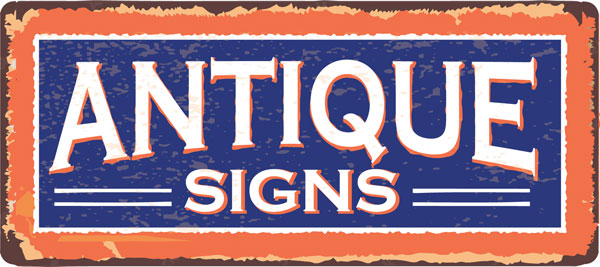The history of enamel advertising signs in the US is a tale of innovation, industrial power and iconic craftsmanship.
Originating in Europe in the mid-1800s, enamel signs quickly captivated the world with their unique visual allure and durability.
By the turn of the century, US entrepreneurs had embraced the trend, sparing no expense to bring European techniques and expertise to their shores.
Over the next 60 years, US companies carved out their own niche, producing timeless designs that continue to resonate with collectors and enthusiasts today.
Here’s a quick look at some of the better-known US manufacturers.
Baltimore Enamel and Novelty Company
Among the most notable pioneers was Baltimore Enamel. Established in 1898, it soon became one of the nation’s largest manufacturers – thanks to the production of enamel vehicle number plates.
In 1903, the state of Massachusetts commissioned them to produce the first official US licence plates, an order that would see them manufacture over 50,000 enamel plates over 5 years.
Their soaring reputation secured similar contracts with other US states, and by 1910 Baltimore was supplying licence plates to 10 states – 20% of the country. In 1915, even the distant island state of Hawaii sought their services.
And then, at the height of their success, disaster struck.
By 1916, cheaper methods of producing licence plates had been developed, and within the space of a single year Baltimore Enamel lost almost all of their contracts.
Nevertheless, the company soldiered on until the advent of the Second World War, producing a range of iconic enamel advertisements for well-known names such as Texaco, Gulf and Sinclair.
These days, Baltimore is treasured for their work, particularly by collectors of petroliana and breweriana, which are oil/gas/motoring and brewery-related signs.
Imperial Enamel Company
Imperial Enamel was originally a respected British sign manufacturer – one of the founding members of the industry.
During their heyday in the 1890s, the company opened a second branch in New York, bringing their enamel expertise to a burgeoning new market.
Imperial soon found work across the US, creating enamel signs for big names such as Western Union, Nestle, Wells Fargo and Bell Telephone. They also specialised in more mundane products, such as street signs and door numbers.
Despite closing its doors in 1910, the branch made a substantial impact with its vibrant designs, and its signs are still appreciated by collectors today.
Ingram-Richardson
Founded in 1901 by two English immigrants, Ingram-Richardson rose from the ashes of perhaps the first US enamel sign-maker – the Enameled Iron Company.
Known to the locals as ‘Ing-Rich’, the company immediately made a name for itself, producing not only enamel signs, but a range of enamelled homeware, furnishings and building exteriors.
Like Baltimore Enamel, they also found success with state-issued licence plates. Just three years after opening, they were producing enamel plates for Philadelphia and soon rose to become the only rival to Baltimore’s licence plate empire, eventually working with 9 US states and a Canadian province.
By 1915, Ing-Rich was firmly established as a leading enamel manufacturer, with factories in 4 states and over 1,000 employees.
Renowned for the durability of their enamel, they flourished in the sign-making business until the 1960s (apart from a foray into the production of tank armour and aircraft components during the Second World War).
With their now-classic designs, Ing-Rich left an indelible imprint on countless industries ranging from oil and gas to ice cream, soap and beer.
Burdick Enamel Sign Company
Another early adopter, Burdick Enamel Sign Company, was founded in Chicago in 1895.
With a reputation for quality, Burdick soon became known for their distinctive curved corner designs and tin embossments. They served a roster of corporate giants, such as General Motors, Pepsi, Kellogg and John Deere.
With factories strategically located in New York, Boston and Beaver falls, Burdick’s influence spanned the breadth of the country.

